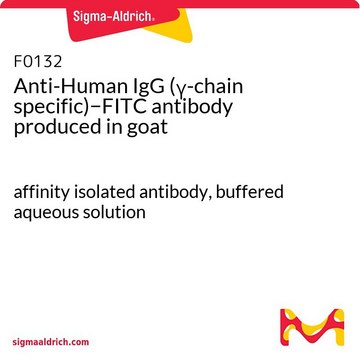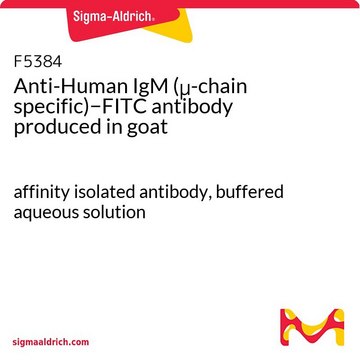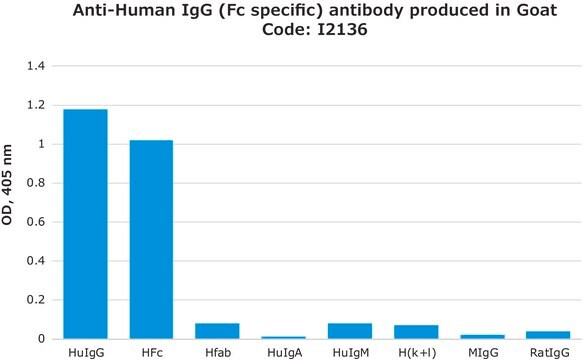F6380
Anti-Human IgG (γ-chain specific)−FITC antibody produced in goat
IgG fraction of antiserum, buffered aqueous solution
Autenticatiper visualizzare i prezzi riservati alla tua organizzazione & contrattuali
About This Item
Prodotti consigliati
Origine biologica
goat
Coniugato
FITC conjugate
Forma dell’anticorpo
IgG fraction of antiserum
Tipo di anticorpo
secondary antibodies
Clone
polyclonal
Stato
buffered aqueous solution
tecniche
direct immunofluorescence: 1:32
Temperatura di conservazione
2-8°C
modifica post-traduzionali bersaglio
unmodified
Cerchi prodotti simili? Visita Guida al confronto tra prodotti
Descrizione generale
IgG antibody subtype is the most abundant serum immunoglobulins of the immune system. It is secreted by B cells and is found in blood and extracellular fluids and provides protection from infections caused by bacteria, fungi and viruses. Maternal IgG is transferred to fetus through the placenta that is vital for immune defence of the neonate against infections
Anti-Human IgG (γ-chain specific)-FITC antibody is specific for human IgG subclasses. Whole antiserum is fractionated and then further purified by ion exchange chromatography to provide the IgG fraction of antiserum. Goat anti-human IgG is conjugated to Sigma Fluorescein Isothiocyanate (FITC).
Anti-Human IgG (γ-chain specific)-FITC antibody is specific for human IgG subclasses. Whole antiserum is fractionated and then further purified by ion exchange chromatography to provide the IgG fraction of antiserum. Goat anti-human IgG is conjugated to Sigma Fluorescein Isothiocyanate (FITC).
Immunogeno
Pooled normal human serum
Applicazioni
Anti-Human IgG (γ-chain specific)-FITC antibodymay be used for immunofluorescent labelling of human peripheral blood lymphocytes at a working antibody dilution of 1:32 or 1:130. was used to determine IgG isotypes on human RBC by exhaustive photon reassignment microscopy.
Stato fisico
Solution in 0.01 M phosphate buffered saline, pH 7.4, containing 15 mM sodium azide as preservative
Esclusione di responsabilità
Unless otherwise stated in our catalog or other company documentation accompanying the product(s), our products are intended for research use only and are not to be used for any other purpose, which includes but is not limited to, unauthorized commercial uses, in vitro diagnostic uses, ex vivo or in vivo therapeutic uses or any type of consumption or application to humans or animals.
Non trovi il prodotto giusto?
Prova il nostro Motore di ricerca dei prodotti.
Codice della classe di stoccaggio
10 - Combustible liquids
Punto d’infiammabilità (°F)
Not applicable
Punto d’infiammabilità (°C)
Not applicable
Scegli una delle versioni più recenti:
Possiedi già questo prodotto?
I documenti relativi ai prodotti acquistati recentemente sono disponibili nell’Archivio dei documenti.
U Specks et al.
Clinical and experimental immunology, 109(2), 286-295 (1997-08-01)
We have expressed conformationally intact, enzymatically active recombinant PR3 in HMC-1 cells (HMC-1/PR3 cells) that is recognized by C-ANCA. Here we directly compared the clinical utility of C-ANCA testing by indirect immunofluorescence (IIF) using HMC-1/PR3 cell cytospin versus polymorphonuclear neutrophil
B Pouvelle et al.
Nature medicine, 6(11), 1264-1268 (2000-11-04)
A common pathological characteristic of Plasmodium falciparum infection is the cytoadhesion of mature-stage-infected erythrocytes (IE) to host endothelium and syncytiotrophoblasts. Massive accumulation of IE in the brain microvasculature or placenta is strongly correlated with severe forms of malaria. Extensive binding
Ingrid J G Burvenich et al.
mAbs, 8(4), 775-786 (2016-04-01)
IgG has a long half-life through engagement of its Fc region with the neonatal Fc receptor (FcRn). The FcRn binding site on IgG1 has been shown to contain I253 and H310 in the CH2 domain and H435 in the CH3
J Gysin et al.
Infection and immunity, 67(12), 6596-6602 (1999-11-24)
We performed ex vivo experiments with Plasmodium falciparum-infected human placentas from primi- and multigravida women from Cameroon. All women, independent of their gravida status, had anti-chondroitin sulfate A (CSA) adhesion antibodies which cross-reacted with heterologous strains, such as FCR3 and
Irina B Torres et al.
Clinical transplantation, 28(10), 1148-1154 (2014-08-12)
Transplant glomerulopathy (TG) is the characteristic lesion of chronic antibody-mediated rejection (AMR). However, in some patients presents with no circulating HLA antibodies or C4d positivity. Patients with TG accomplishing criteria for chronic AMR were compared to patients with isolated TG.
Il team dei nostri ricercatori vanta grande esperienza in tutte le aree della ricerca quali Life Science, scienza dei materiali, sintesi chimica, cromatografia, discipline analitiche, ecc..
Contatta l'Assistenza Tecnica.








